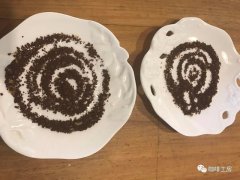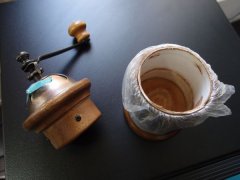How to adjust the thickness of the manual bean grinder? OE Lido2 hand coffee grinder [operating instructions]

Professional barista communication, please pay attention to coffee workshop (Weixin Official Accounts cafe_style)
The Lido2 coffee grinder in your hand is assembled and finished. Before use, just screw on the bottom of the glass powder jar, set the scale, put in coffee beans, you can start grinding!
√ Set grinding scale
The grinding scale is adjusted by using two rotary rings with scales in the middle of the bean grinder body. The wider is the adjustment scale (grinding thickness), hereinafter referred to as the "adjustment ring", the thinner rotating ring hereinafter referred to as the "fixed ring".
* When adjusting the grinding scale, the bottom glass powder container can be screwed on the main body or not.
When shipped from the original factory, the grinder scale has been calibrated to zero, i.e., the black marked scale marks on the adjustment ring are aligned with the fixed ring scale marks and aligned with the shorter scale marks above the fixed ring.
* Below the screws engraved with LIDO2 lettering there is a short graduation mark and a large and small dot on both sides.
When starting to set the scale, holding the grinder (handle up), first unscrew the fixed ring counterclockwise, turn the adjusting ring clockwise (scale adjustment), with the adjustment ring turning left and right, the inner cutter disc and bearing connected with it will move up and down (change the distance between the inner and outer cutter discs and adjust the grinding scale).
When you have rotated the adjustment ring to the desired graduation, tighten the retaining ring clockwise to the adjustment ring (the retaining ring is fixed toward the adjustment ring). This way you have finished setting the scale and can start grinding.
When making fine adjustment of scale, first unscrew the fixed ring counterclockwise, rotate the adjusting ring clockwise = coarse scale adjustment, rotate the adjusting ring counterclockwise = fine scale adjustment, after setting, remember to lock the fixed ring again to fix the setting scale.
There are 16 graduations on the rotating ring, and the bean grinder can rotate at most 2 1/4 turns from zero.
Recommended grinding scale (from zero)
1. Espresso: Approximately 10 steps.
2. Follicular Brewing Coffee: Approximately 16 graduations, i.e. one rotation to the black line mark. 3. Immersed coffee: about 16+8 spaces, i.e. rotate once and then 8 spaces.
The Lid02 is a fairly intuitive bean grinder, but it takes time to master it. Most users tend to lock the retaining ring and adjusting ring because the retaining ring locks too tightly. The solution is to hold the set of adjusting and fixing rings that cannot be rotated and try to rotate the ring set left and right. When the ring set is loose from the main cutter head seat, you can release the two rings. If you still can't rotate the entire ring set, find a mallet with no grooves and tap the two ring sets sideways to release them!
When taking ground coffee out of the coffee pot, hold the metal part of the body and unscrew the glass pot instead of the transparent coffee bean slot above the body, otherwise it may rotate to the bearing, causing the grinding scale to run away.
After using Lido2 for a while, the cutter head rotates more smoothly and the grinding speed is faster. But we do not recommend using rice or other non-coffee substances to test grinding or honing knives, only coffee beans!
√ Cleaning and maintenance
[Daily/after each use] Use the small brush included in the original factory to brush off the coffee grounds near the grinding plate (bottom).
[big clean] use the original attached small screwdriver, first loosen the body above the lock handle screws, remove the handle, clockwise rotation to loosen the body at the bottom of the adjustment ring, you can remove the inner cutter and bearing connected with the adjustment ring, you can use a brush thoroughly clean the inner cutter and bearing!
If you want to clean the transparent bean tank more bright, you can loosen the screws connected to the top of the bean grinder, remove the top metal cover, and gently wipe the inside of the transparent body with a soft cloth. If you want to clean the parts of this grinder with water, use a neutral detergent, clean them thoroughly and dry them thoroughly before assembling.
* Not recommended to wash in dishwasher!
* It is not recommended to disassemble the outer disc and transparent bean groove under the body, because the reassembly process may cause the axis to shift.
√ Small step
The concept of Lido2 hand-operated coffee grinder is that each user can create their own skills, so we use an unmarked adjustment ring, which allows users to develop their own marks or memories of grinding scales according to their personal habits or preferences. For example, the designer himself uses the method of calculating the scale, while some people use a pen as a mark or stick a sticker on the customary scale. So find your own way--
Lido2 Grinding requires holding with both hands and supporting the bottom against something (reaction force), such as a table or body. The easiest way is to hold the transparent body of the grinder in one hand, hold the rotating handle in the other hand, lean the bottom glass jar against the body (or sit or stand) or bar counter, tilt the grinder 30 degrees, and the hand holding the rotating handle can start grinding like a bicycle. A very natural, effortless and smooth grinding process is ideal!
Due to the different environment and grinding beans, it may lead to more or less electrostatic phenomenon, so there will be a small number of the lightest weight coffee powder, or silver skin residue in the body of the lowest knife head area. If you want to reduce static electricity phenomenon, in the beginning of brewing coffee pre-ground coffee powder, let it stand to slow down the static phenomenon, another way is to gently spray a thin layer of water mist on the coffee beans before grinding, or drop one or two drops of water on the coffee beans, this can effectively remove static phenomenon.
However, static electricity often helps to adsorb lighter coffee substances, such as silver skins, fines, and powders, which may not be what you want to extract.
* End
Important Notice :
前街咖啡 FrontStreet Coffee has moved to new addredd:
FrontStreet Coffee Address: 315,Donghua East Road,GuangZhou
Tel:020 38364473
- Prev

How to choose your coffee grinder? Practical parameters of bean grinder calibration thickness
Professional barista communication please follow the coffee workshop (Wechat official account cafe_style) according to the conditions and needs of guests to choose the appropriate grinding plate, there is no 100% authoritative regulation in the coffee industry, diversity is the origin of the world, since many people are entangled with bean grinders, here are some practical information. 1. The grinding standard is the same, but the flavor is different. The core grinding plate of the bean mill is mainly divided into cone grinding plate and flat grinding.
- Next

Hmur5 Post Box hand Bean Mill scale Adjustment to solve the problem of Bean Mill Calibration thickness and static electricity
For professional baristas, please follow the Coffee Workshop (official Wechat account cafe_style) about Hmur5 mailbox hand bean grinder the following two web sites have a very clear introduction: Hmur5 mailbox hand bean grinder mailbox type hand bean grinder assembly shows that this hand bean grinder is really quite easy to use, especially in the case of only making yourself a cup of coffee.
Related
- Beginners will see the "Coffee pull flower" guide!
- What is the difference between ice blog purified milk and ordinary milk coffee?
- Why is the Philippines the largest producer of crops in Liberia?
- For coffee extraction, should the fine powder be retained?
- How does extracted espresso fill pressed powder? How much strength does it take to press the powder?
- How to make jasmine cold extract coffee? Is the jasmine + latte good?
- Will this little toy really make the coffee taste better? How does Lily Drip affect coffee extraction?
- Will the action of slapping the filter cup also affect coffee extraction?
- What's the difference between powder-to-water ratio and powder-to-liquid ratio?
- What is the Ethiopian local species? What does it have to do with Heirloom native species?

